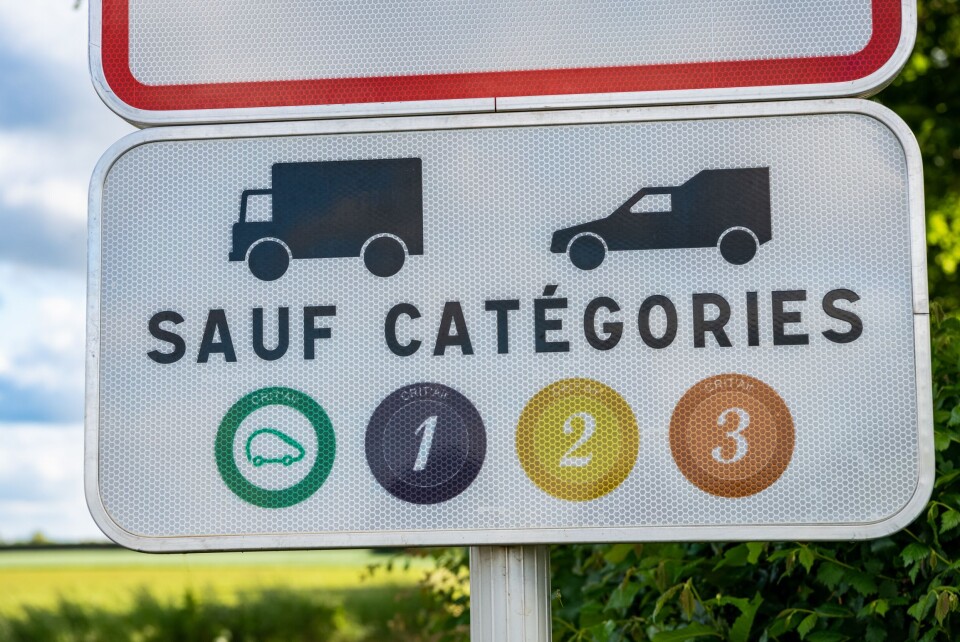-
White storks make strong return in France via nest ‘platforms’ and clipped wings
The Ligue pour la Protection des Oiseaux shares the conservation challenges in saving these birds from extinction
-
Hosting scheme in south-west France lets newcomers sample lifestyle
Households in nine Dordogne communes volunteer under Mes Nouveaux Voisins scheme
-
French boulangeries demand right for staff to work on May 1 so they can open
Artisan bakery owners can work but employees cannot, while certain industrial bakeries are allowed to remain open with workers
Is this the beginning of the end for France’s low-emission zones?
The French government says it will ease restrictions in some of France’s low-emission zones, but critics say it will kill them off

The government says it will ease restrictions in some of France’s controversial low-emission zones to make them more “socially fair and accepted”.
Critics say the move will be the ‘death’ of the zones, which seek to improve air quality by banning the most polluting vehicles from entering.
Christophe Béchu, Minister for the Ecological Transition, said the government would not be changing the law but instead “specifying which rules apply”.
A dozen French cities currently have low-emission zones - called zones à faibles emissions (ZFEs) - including Paris, Lyon, Toulouse and Nice. But legislation will push all urban areas with a population greater than 150,000 to introduce them by 2025.
But Mr Béchu says these 43 urban areas will now be split into two groups.
The first one is the group of ‘effective ZFEs’. These are the cities that regularly exceed the European thresholds for air quality. They are Paris, Lyon, Aix-Marseille, Rouen, and Strasbourg. For these, the restrictions will stay in place.
“This will enable us to concentrate our resources and support these five areas. These cities were required to ban Crit'Air 5 vehicles on January 1, 2023; and must ban Crit'Air 4 vehicles on January 1, 2024; and Crit'Air 3 vehicles on January 1, 2025,” he said.
The second group, which meets European thresholds, will become “territories of vigilance”. This means restrictions will be eased.
“If you are not over the threshold, you have no legal obligation to expand the list of restrictions year after year,” said Mr Bechu.
For the other towns or cities which have not yet started the deployment of the ZFE, only one obligation: to restrict by 2025 the circulation of cars registered before December 31, 1996, which do not have a Crit'Air sticker.
“That is to say a little less than 3% of the overall vehicle fleet of this country”, he said.
“The aim of ZFEs is not to annoy the public…but to act on the number of deaths linked to atmospheric pollution,” Mr Bechu added.
The government move came as a report by the France urbaine association - which represents large towns in the country - issued recommendations to improve ZFEs.
The main measures recommended include:
- Make residents and users of neighbouring areas affected by the introduction of ZFE eligible for state aid, in the same way as those living in a ZFE
- Revise the Crit'Air sticker to take account of the actual level of pollution and not just the age of the vehicle
- Double government aid, especially the prime à la conversion, and supplement it with regional aid
- Set up a one-stop shop in the area to implement the ZFE and simplify procedures for residents
- Improve alternative forms of transport, including in suburban areas
- Enable heavy goods vehicles and light commercial vehicles rated Crit'Air 0, Crit'Air 1 and Crit'Air 2 vehicles to be authorised to drive until 2030
The report concluded: “France urbaine [association] believes that each of the proposals put forward in the report must be taken into account if ZFEs are to become truly acceptable and therefore effective.”
It then said that it did not recommend that authorities be sanctioned if they were unable to comply with these ZFE requirements yet.
Read more: Map: See France’s low emission driving zones - and plans for new ones
‘The death of low-emission zones’
But Mr Bechu’s announcement was heavily criticised by clean air campaigners Respire, which has condemned them as “a scandal” and “the death” of the low-emission zones.
Association director Tony Renucci told FranceInfo: “They [the government] haven’t understood a thing. Air quality is improving, but it’s bad in France. People die [from pollution] every year.
“I think these measures are the death of the ZFEs. What’s been announced is a U-turn. It’s very hypocritical. We cannot say that we have complied with emission thresholds when we know today that they are far too high in relation to the health emergency.
“Either the government is completely ignorant of the subject, or it is doing this in full knowledge of the facts, in which case it is a hypocritical and even dangerous abandonment of public health.
“I think it's a scandal. They haven’t understood anything about the urgency of our air quality.”
He added that the new measures sent a negative message.
He said: “Do you realise the message we're sending out to the public? It's a way of saying that there's no need to make any more effort and that everything's fine. But that's not the case at all. Air quality is poor in France. It's improving, but it's still bad.
He said that the announcements were “completely counter-productive, incoherent, and non-strategic”, and would not help fight pollution.
Read also
How to avoid driving in French low-emissions zones
Low-emission zones are a bad idea, say French greens
Confusion over low-emission driving zones in France
























